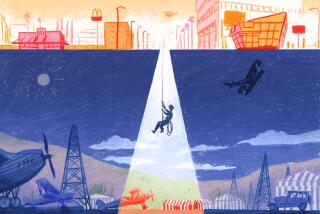EL TORO AIR SHOW : Old B-24 Restores Memories
Henry W. Wedaa remembers with a certain fondness the bombing missions he flew through enemy fire over Nazi Germany during World War II.
“I wouldn’t have missed it for the world, but I’m not sure I’d do it again,” said the 67-year-old former bombardier.
This weekend, he has good reason to recall those days. A souvenir of Wedaa’s military service--a B-24 like the one he flew during 30 bombing raids in the spring of 1944--will be parked on the airfield at the El Toro Air Show. It is the world’s only restored and flyable B-24, and Wedaa’s name is on it. Literally.
The Yorba Linda city councilman is looking forward to visiting it.
“It’s sort of a nostalgic binge. You get to relive the days of your youth,” Wedaa said.
The hundreds of names emblazoned on the Liberator’s side represent contributors to the plane’s restoration. There are fewer than 10 of the original 18,000 planes left today, said Bob Collings, co-founder of the Stow, Mass.-based group that restored it.
“It was the most produced aircraft ever, yet there’s not even one in the Smithsonian,” Collings said.
Collings said he purchased the plane for an undisclosed amount in 1984 after seeing an advertisement in a trade magazine. After the war, it flew as part of the Indian Army for 20 years. During that time, others like it were being less productive in their homeland.
“We were chopping them up and making pots and pans out of them,” Collings said.
The $1.3-million restoration project, completed in 1989, took 97,000 hours. Today, the world’s only restored and flyable Liberator is among other refurbished historical planes belonging to the Collings Foundation, a nonprofit educational group that re-enacts historic events and restores artifacts. Others in the collection include a B-17 Flying Fortress and an A-26 attack plane.
To date, Collings has solicited contributions totaling more than half the B-24’s restoration cost from 2,500 individuals and 35 corporations, he said. Wedaa heard about the project while attending a reunion of his bomber group in Chicago five years ago and donated $1,000.
“These represent a very important part of history,” Collings said. “There’s great emotional involvement. The stories that these guys can tell--some of them are history, some of them are gut-wrenching, some are just humorous.”
Wedaa’s story begins when he was 19 and joined the Army Air Corps after the war started. Wedaa, a bombardier with the 467th Bomb Group of the Second Air Division of the Eighth Air Force, targeted and bombed sites from a B-24 flying 22,000 feet above German cities during World War II. He earned five medals, including the Distinguished Flying Cross.
He discovered that flying, a new mode of travel for him, was a thrill.
“When you’re 20 years old, flying a mission like this, it’s got to be exciting,” he said. “Of course, it gets real exciting if you get hit.”
Although the crew was never forced down by artillery shells, it often had to guide “straggling” planes riddled with flak back to the base in Rackheath, near Norwich, England.
Once, the crew had to throw everything--supplies and all--overboard because two of the plane’s four engines had been damaged by flak. And Wedaa recalls more than one occasion when he had to climb below into the bomb bay to physically dislodge a bomb that had become stuck.
“So here I am over the North Sea down on the bomb racks and kicking the bombs loose,” he recalled.
He said the one mission he flew to bomb railroad yards in Berlin was scariest because it lasted 10 to 12 hours, leaving enemy pilots plenty of time to refuel and come back at them. “It was a long haul,” he said. “You knew that you’d be attacked going in and coming out.”
He has returned to the base near Norwich twice since 1944, accompanied by his son as they traveled to other European countries. He said a few buildings are still standing, and the walls still bear the scribblings of pilots, who recorded their mission data there.
The building where he lived, however, is gone. He shrugs off any suggestion of sadness over this, saying, “It was an event in one’s life, and you move on.”
Today, Wedaa has shifted his attack from enemy territories to local issues, holding seats on various boards and committees. He is vice chairman of the South Coast Air Quality Management District and chairman of the Southern California Assn. of Governments’ aviation committee.
He has also been a member of the Yorba Linda City Council for 20 years, serving as mayor five times.
A father of four, Wedaa said he was eager to help restore the B-24 because it is important to preserve history for future generations.
“There are very few of these around. I think it’s important for our children to see the weapons we used in World War II,” he said, adding that they are “primitive” in contrast with the weapons used during the Persian Gulf War.
“We just directed and dropped and hoped (the bomb) went there. But these guys today--they take it and guide it all the way in.”
Wedaa said he’s looking forward to seeing the plane, but he intends to do more than walk around it.
“They owe me a ride,” he said, “and I intend to collect.”
More to Read
Sign up for Essential California
The most important California stories and recommendations in your inbox every morning.
You may occasionally receive promotional content from the Los Angeles Times.










